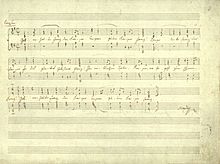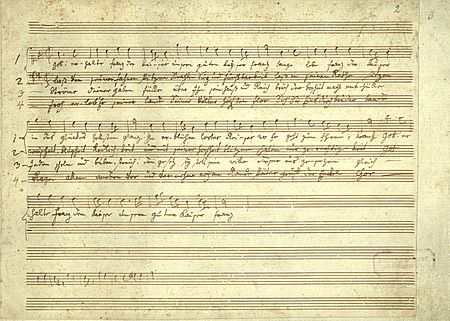Gott erhalte Franz den Kaiser facts for kids
| English: 'God Save Francis the Emperor' | |
|---|---|

Autograph score of the original version
|
|
| Lyrics | Lorenz Leopold Haschka |
| Music | Joseph Haydn, 1797 |
The "Gott erhalte Franz den Kaiser" (which means 'God Save Francis the Emperor'), also known as the "Kaiserhymne" (or 'Emperor's Hymn'), is a famous piece of music composed by Joseph Haydn in 1797. It was first created with words by Lorenz Leopold Haschka as a patriotic song. This song showed loyalty to Emperor Francis II of the Holy Roman Empire. Haydn's beautiful melody became very popular and was later used in many different ways, often with new lyrics. For example, the third verse of the "Deutschlandlied", which is the current national anthem of Germany, uses this very tune. You can also find this melody in other classical music pieces, Christian hymns, and even school songs.
Contents
What is the "Emperor's Hymn"?
The original lyrics for the "Emperor's Hymn" were written in German. Here is the English translation of the first verse:
God save Francis the Emperor, our good Emperor Francis!
Long live Francis the Emperor in the brightest splendour of bliss!
May laurel branches bloom for him, wherever he goes, as a wreath of honour.
God save Francis the Emperor, our good Emperor Francis!
How the Song Was Created
This special song was written in 1797 when Austria faced many challenges from other countries. People felt very patriotic and wanted to show their support for their nation and its leader.
A man named Anton Schmid, who worked at the Austrian National Library, shared the story of how the song came to be. He explained that Joseph Haydn, a famous composer, had visited England. There, Haydn was impressed by the British national anthem, "God Save the King". He wished Austria could have a similar song to express love and respect for its ruler.
Haydn shared his idea with a friend, Freiherr van Swieten, who was an important supporter of arts and sciences. Van Swieten then spoke with Franz Count von Saurau, a high-ranking official. Together, they decided to create a national song for Austria. Count Saurau asked the poet Lorenz Haschka to write the words and then asked Haydn to compose the music.
In January 1797, both tasks were completed. The "Gott erhalte Franz den Kaiser" was first performed on Emperor Francis II's birthday, February 12, 1797. The song quickly became popular and was unofficially used as Austria's first national anthem.
Joseph Haydn's Creative Process
Some people believe that Haydn might have used parts of old folk songs he knew when composing this tune. Others think that his original melody was so good that people later adapted it into folk songs. Either way, Haydn put a lot of effort into perfecting his composition.
Haydn's early drafts, which are kept in the Vienna National Library, show how carefully he worked. He made many changes, removing parts that were "too interesting" too early, to make sure the song's most powerful moments had the biggest impact.
The first version of the song was quite simple, with a single voice part and basic piano music. This version was sent to theaters across Austria for performances. The very first public performance happened in Vienna on February 12, 1797, during the Emperor's 29th birthday celebration.
Haydn later created three more versions of his song:
- He made an orchestral version, which sounded much richer and more complete.
- He also used the tune as the main theme for a slow movement in one of his string quartets. This quartet, known as the "Emperor Quartet", is one of his most famous works. In this version, each instrument in the quartet takes a turn playing the melody.
- Finally, Haydn made a piano version of the quartet movement, which was published in 1799.
Haydn's Special Connection to His Song
Joseph Haydn truly loved his "Emperor's Hymn." In his later years, when he was old and not feeling well, he would often go to his piano to play the song. It brought him comfort. His servant, Johann Elssler, shared that it was the very last music Haydn ever played. On May 26, 1809, just days before he passed away, Haydn played the hymn three times with great emotion, surprising even himself with how well he played it.
The Tune's Influence in Classical Music
Haydn's melody was so memorable that many other famous composers used it in their own works. When they included the tune, it often reminded listeners of Austria, its patriotism, or its monarchy. Here are a few examples:
- Ludwig van Beethoven used the tune in a piece celebrating the end of the Napoleonic Wars in 1815.
- Carl Czerny wrote variations for piano and orchestra based on the hymn in 1824.
- Niccolò Paganini, a famous violinist, created a set of variations for violin and orchestra in 1828.
- Clara Schumann, a talented pianist and composer, used the tune for her "Souvenir de Vienne" in 1838.
- Pyotr Ilyich Tchaikovsky arranged the work for orchestra in 1874.
The Tune's Journey: From Austria to Germany
Haydn's melody has had a long and interesting journey, becoming part of national anthems, school songs, and hymns.
"Emperor's Hymn" in Austria-Hungary
| English: Emperor's Hymn | |
|---|---|
| Imperial anthem of | the Habsburg monarchy |
| Also known as | Gott erhalte, Gott beschütze English: God preserve, God protect Volkshymne English: People's Hymn |
| Lyrics | Johann Gabriel Seidl, 1854 |
| Music | Joseph Haydn, 1797 |
| Adopted |
|
After Emperor Francis II passed away in 1835, the tune received new lyrics to honor his successor, Emperor Ferdinand. Later, when Francis Joseph became emperor, the original lyrics were used again because he also had the name Francis. In 1854, new lyrics were chosen, starting with "God preserve, God protect / Our Emperor, our country!" The hymn was translated into many languages spoken across the Austro-Hungarian Empire.
However, after the First World War ended in 1918, the Austro-Hungarian Empire changed significantly. Austria became a republic and no longer had an emperor. The government decided to find a new national anthem to represent the new republic. The "Kaiserhymne" was no longer used for official purposes.
In 1929, the hymn was briefly revived with completely new lyrics, becoming Austria's national anthem until 1938. Even after it was no longer official, the tune kept its connection to the former royal family. For example, the 1854 version was sung at the funerals of Empress Zita in 1989 and her son Otto von Habsburg in 2011.
Germany's National Anthem
Many years after Haydn's death, his melody was chosen for a poem called "Das Lied der Deutschen" (The Song of the Germans), written in 1841. Today, the third stanza of this poem, which begins "Einigkeit und Recht und Freiheit" (Unity and Right and Freedom), is sung to Haydn's tune and is the official national anthem of Germany.
The Tune in Hymns and School Songs
The melody of "Gott erhalte Franz den Kaiser" is also known as "Austria" or "Austrian Hymn" in church music. It has been paired with various religious lyrics, such as "Glorious Things of Thee Are Spoken" and "Praise the Lord, Ye Heavens Adore Him."
This famous tune has also been adopted by many schools as their official song, or alma mater. Some examples include:
- The alma mater of Columbia University, "Stand, Columbia"
- The alma mater of the University of Pittsburgh
- The school song of Kwun Tong Government Secondary School
- The alma mater of Illinois State University
Understanding the Original Lyrics
The original 1797 German lyrics of the "Emperor's Hymn" were translated into many languages. Here is the first verse in English:
| English translation |
|---|
|
I |
See also
 In Spanish: Himno nacional del Imperio austrohúngaro para niños
In Spanish: Himno nacional del Imperio austrohúngaro para niños
- Heil dir im Siegerkranz



